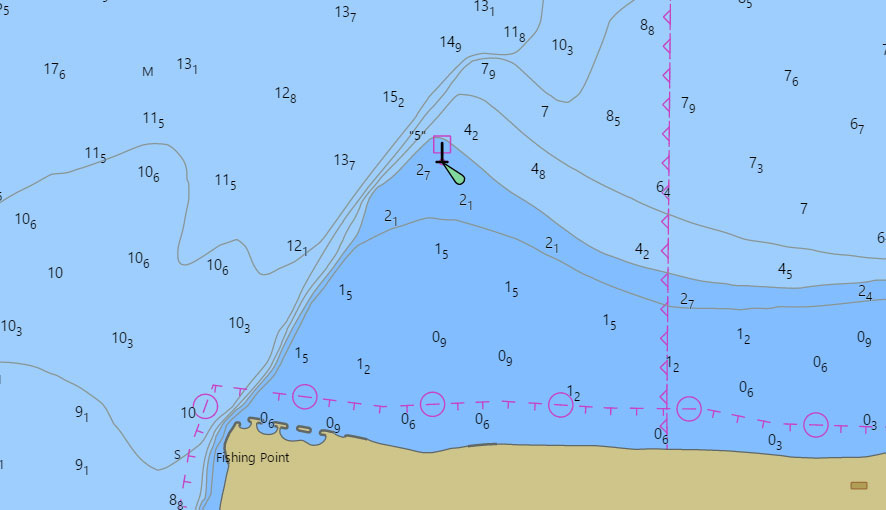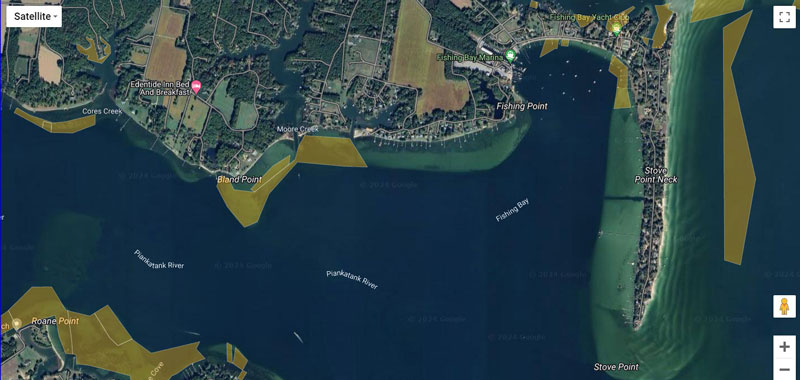Wherever you enjoy your Chesapeake Bay fishing and whatever species you hope to catch, when it comes to casting in the shallows, finding fish-attracting structure is often a key to success. And while all structure is not created equal, there’s plenty of stuff we see with our eyes on a regular basis which most of us ignore. Sure we know to cast to stuff like riprap, points, and piers. But what about…

DUCK BLINDS – If you’re a striped bass, a white perch, or a redfish, do you really care whether those pilings have boards up above or are covered with a big, bushy blind? Of course not. And although many anglers never think to cast to them blinds can be quite bountiful.
For a duck blind to be a good fishing spot all of the usual prerequisites do apply: the blind needs to be in an area with moving current, sufficiently deep water, and relatively close access to deeper water. Expect that high or incoming water will usually be better than low water. In this case, however, there’s one more requirement and it’s an important one when fishing in the fall—the blind can’t be occupied. If you see a bunch of ducks hanging out nearby steer clear, because those ducks are decoys.
TIP: Many offshore blinds have a tunnel of sorts on the land side, which is where the duck hunters park their boat. Position yourself so you can cast up inside of that tunnel, placing your lure deep in the structure where the most dominant fish (read: the largest) will often be hanging out.
FIXED CHANNEL MARKERS – We blast by those markers time and again, but if you pull back the throttles and take a cast every few times the results might be magical. Multi-pole markers, in specific, are the ones to look for. That’s not to say a single pole marker isn’t worth a poke or two but far more regularly triples or quads do the trick. And it isn’t just the poles that attract the fish. Where do they put those markers? On channel edges, often where long points that jut out from land drop off into deep water. So fixed markers don’t just represent structure, they represent structure strategically placed in an area that fish frequent in any case.

TIP: Since fixed markers tend to be deeper than other “shallow” water structure, try probing the water column from top to bottom. On the first cast make an immediate retrieve; on the second let your offering fall to mid-depth; on the third let it fall all the way to bottom.
TRIBUTARY OYSTER BARS – They may be fewer and farther between than they used to be, but all the tributaries from the Magothy south have some remnants at the very least and the farther south you go the more live oysters you’ll find. It’s a fair bet you’ve fished oyster bars with success in the open Bay before, but have you ever fished bars inside the river? Most anglers never give it a shot—and that’s a shame, because they do often hold fish.

You can encounter just about any species over live bottom, but where these bars really shine is for white perch, spot, croaker, and (more so in days past) weakfish. The next time a breeze has you thinking twice about bottom fishing in the Bay, head for a bar in the river and try drifting across it with a bottom rig and some bits of Fishbites bloodworms.
TIP: If you don’t know where they’re located in any given river, you can locate oyster bars with a quick internet search. In Maryland and Virginia they’re all mapped and you can locate them online.
Structure is a funny thing and fish are even funnier. Sometimes you’ll spot what looks like a magnificent fish-attracting magnet, fish it hard, and come up with bupkis. Other times you’ll see something that looks mediocre at best, and fill the cooler in the blink of an eye. Just don’t blink when you go past any of these three fish-attractors, because you can expect that any of them can turn out to be unexpectedly good fishing spots—even if you’ve run right past them 1000 times in the past.